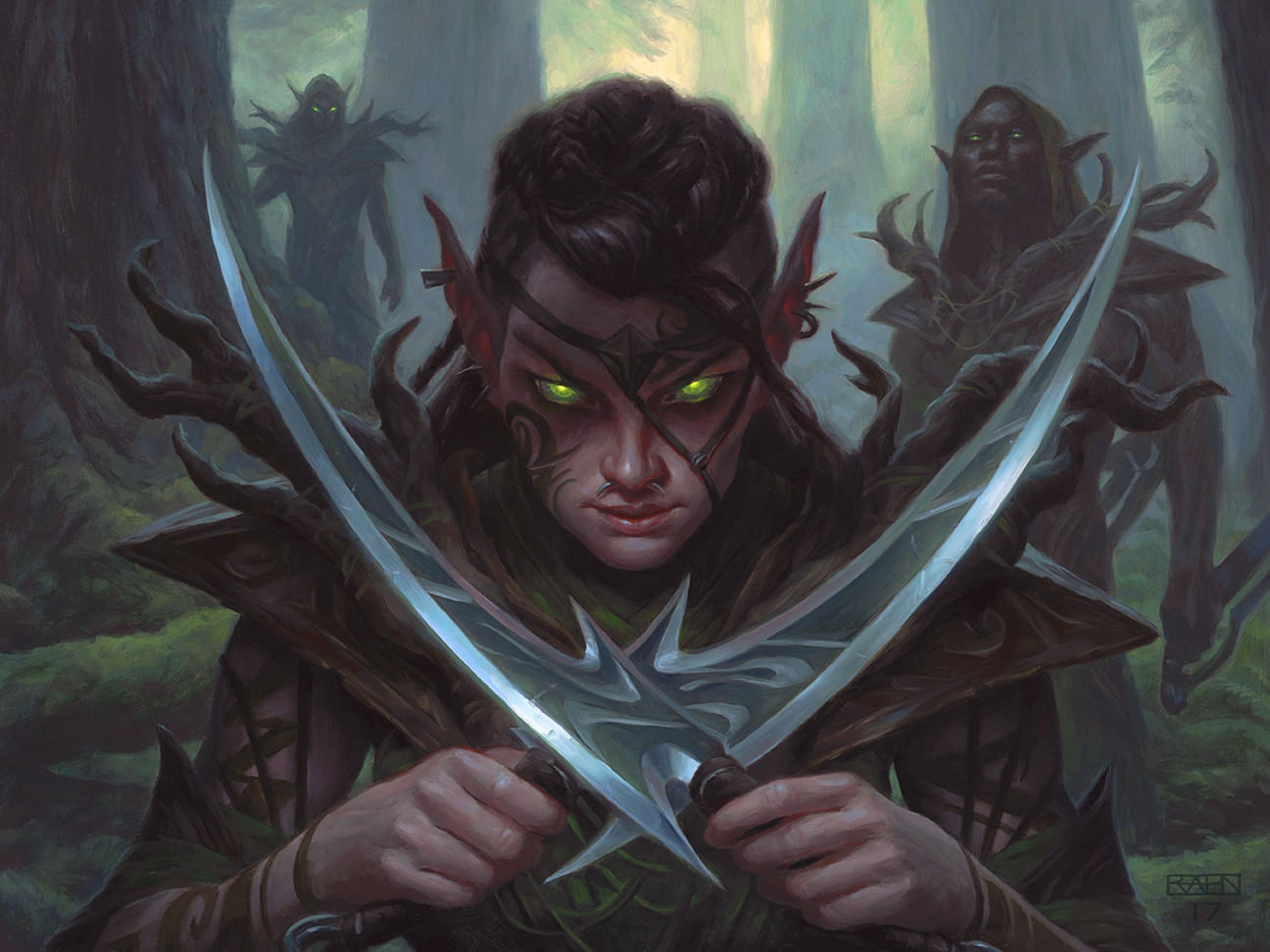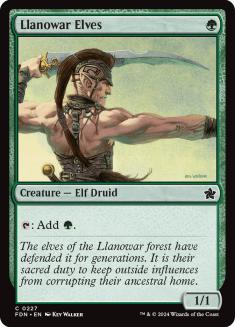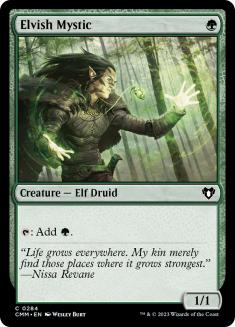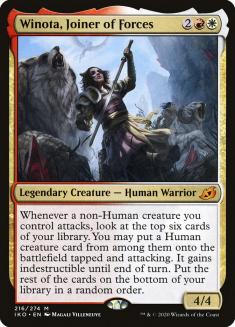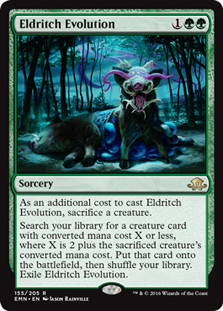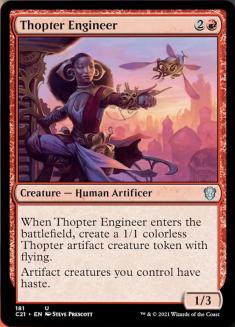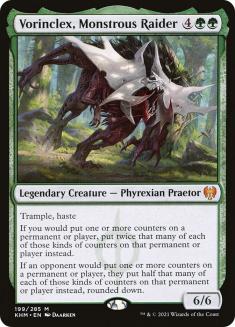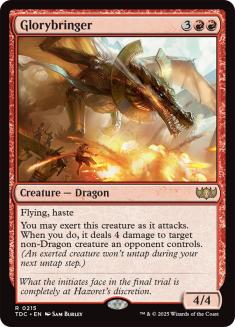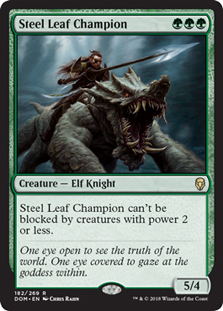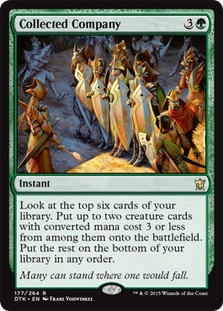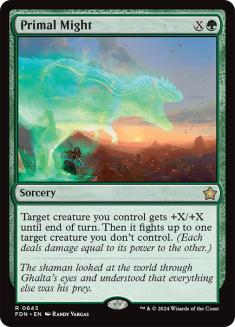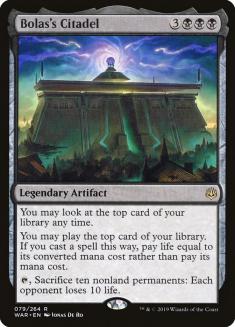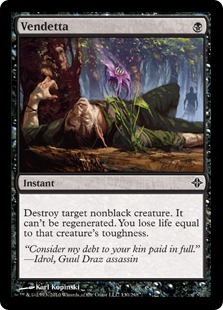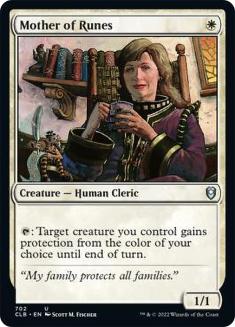Pioneer is a format dominated by its one-mana spells. As formats grow, the card pool swells and powerful spells are printed at cheaper and cheaper costs. Those formats featuring such a vast array of tools will often boil decks down to their best at each casting cost. While the one-mana spells in Pioneer aren’t usually the cards closing down games, they’re often the reason you win or lose.
I don’t have to tell you that Fatal Push is an excellent card. It has seen play in virtually every format since it was printed. Black’s removal was often more clunky, expensive, or situational. That’s the deal: black cards offer versatility at the cost of other resources. The choice is often, “Do you want to spend X life to do this effect for one mana cheaper?”
History has proven that paying that life is often beneficial, which made black one of the better support colors. Fatal Push went one further, removing any real downside in favor of a casual restriction that’s easily avoidable. It’s incredible.
Fatal Push isn’t the only one-mana spell we have to go over today. In fact, we have two and they’re both in the same color!
Mana acceleration is arguably the most powerful mode in Magic because you’re leapfrogging the competition in terms of what level of spells you’re casting. As casting costs increase, so does the power level. Your one-mana spells are often weaker in general than more expensive stuff, but these mana creatures allow you to skip an entire phase of the game.
These two best buds put you on three mana on the second turn. Three-mana threats can regularly overwhelm your opponent given high enough stats or various built-in protections. For as long as I can remember, I’ve loved castingmana creatures into bigger and better spells. The rush of hoping they survive so you can do the “powerful thing” first is a gambler’s delight. The rub is that drawing these creatures is often akin to drawing a land in the later turns. That means the failsafe for these decks will regularly come down to whether or not you can put the bodies to work when their time to shine is long past.
Regardless of how the bodies get used as the game progresses, or if you choose to ignore the body after their initial push, figuring out what to ramp into is equally important. Step one is having your Elf survive. Step two is putting it to work dumping larger and more powerful threats onto the battlefield. Ramping into planeswalkers can protect you from sweepers, which are notoriously brutal against a deck featuring mana creatures. Not only do they wipe away your payoff threats for a small cost, your mana development phase is completely undone. It’s a double whammy that I’m regularly looking to dodge.
Other decks ramp into a solitary three-drop creature and hope to ride it to victory. Others still will try to curve one-three-four in an attempt to bury the opponent by putting far too much pressure on them during the opening bout. If you’re on the draw against an Elf and don’t have one- or two-mana interaction, it’s almost impossible to challenge their creatures in combat. They’re often too big or have some sort of evasion that makes the prospect of blocking a pipe dream.
I believe that to be one of the major reasons why they stopped printing so many one-mana accelerators in Standard. Even Gilded Goose, a mostly one-shot mana accelerator, was messed up in the Oko shell. When green is too good, cutting the mana ramp out from under them is often the easiest way to curb their dominance. I would be surprised to see anything resembling Noble Hierarch in Standard ever again.
No matter how you ramp, or what you ramp into, today’s article will focus on the strengths and weaknesses of five builds. From Garruk’s Harbinger to Bolas’s Citadel, the options are plentiful and each unique in their own way. How you ramp is entirely up to you, and what you ramp into can change like the tides based on the more common forms of interaction. So let’s take a closer look at some of the best Llanowar Elves decks that Pioneer has to offer and hopefully one of them will be right for you.
Naya Winota
Creatures (33)
- 4 Llanowar Elves
- 4 Voice of Resurgence
- 4 Elvish Mystic
- 4 Thopter Engineer
- 1 Pia Nalaar
- 3 Angrath's Marauders
- 1 Kenrith, the Returned King
- 4 Bonecrusher Giant
- 4 Winota, Joiner of Forces
- 4 Kazandu Mammoth
Lands (21)
Spells (6)

Winota, Joiner of Forces is like a combo deck that just gets to play Llanowar Elves. Not only do the bodies of the Elves matter here, but accelerating into a three-drop or casting Winota a turn early is the bee’s knees. It’s rare that your Elves get to do double duty like they do in this Naya Winota deck, and likely the reason for its most recent success.
Stainerson’s build here puts an emphasis on the three-drop creatures but does so under the assumption that your opponent will likely be able to disrupt your ultimate gameplan: casting Winota and slamming with one to three small creatures in hopes that you snag a giant Human off the top. The secondary plan of beating your opponent to death with a rag-tag group of token producers and the like is often pretty effective these days. The banning of so many combos last summer means Thopter Engineer is actually playable.
Eldritch Evolution is pretty sick in this deck, acting as a way to find Winota while providing you with substantial value for sacrificing more expensive creatures. Thopter Engineer giving haste to your Thopters is also pretty incredible considering the only valueable part of Winota is having your creatures attack while Winota is on the battlefield.
The place where this deck falters is against opponents who continuously pick off your creatures while also applying pressure. One-mana removal is obviously strong against you, but especially so when accompanied by one-mana threats. Mono-Black and Mono-Red Aggro are both rough matchups because they prey on opponents who deal themselves damage. Without something like Goblin Rabblemaster to get out of control, and punish your opponent for not blocking, this version is a little bit more midrange and less all-in on the three-drops.
Since Voice of Resurgence is one of our only two-drop creatures, any opponent who kills our Llanowar Elves early might put us pretty far behind. Additionally, drawing some of our big Humans like Angrath’s Marauders effectively means drawing a dead card. In some attrition-based matchups, this can be a huge negative, as you usually need all of your available resources to continue applying pressure in the face of resistance.
If you like explosive finishes or one-card combos, this Elf deck might be the one for you. It’s in the camp of “high risk, high reward,” but that can often be some of the most fun Magic you can play. The dance of trying to stick a threat and Winota against a removal-heavy opponent leads to some incredible back-and-forths.
Mono-Green Devotion
Creatures (22)
- 4 Llanowar Elves
- 4 Burning-Tree Emissary
- 4 Elvish Mystic
- 3 Incubation Druid
- 4 Voracious Hydra
- 3 Vorinclex, Monstrous Raider
Planeswalkers (12)
Lands (22)
Spells (4)

My baby, my darlin’. Mono-Green Devotion has been getting some love lately and I’m here for it. My list is a bit different from the usual builds, utilizing the explosiveness of Incubation Druid with Nissa, Voice of Zendikar instead of the much more consistent Wolfwillow Haven. My hope is that the explosive draws outweigh the consistency, as I’m opting to overload my opponent’s cheap removal instead of trying to dodge it.
Mono-Green Devotion is consistent above all else. It’s such a powerful core without opposing interaction, I’d rate it as one of the most powerful “goldfish” decks I’ve ever played. Without opposing interaction, the odds of a Turn 4 Ulamog are somewhat reasonable. An early Nissa, Who Shakes the World can get out of control without much effort. Even Voracious Hydra, one of the more innocuous spells in the deck, ends up being one of the most back-breaking. Tagging opposing creatures in the early-game or being a giant threat that fights later on means it’s versatile along the curve. Cards that are variable in power level based on how much mana you have give their strength to a deck that ramps so quickly and aggressively.
Running one color gives you stability. Mono-Green Devotion thrives on its mana being untapped and pain free. Playing a single color often restricts your abililty to interact on some fundamental level, but green in Pioneer seems to give you all the necessary tools without much fuss. There’s a reason why a lot of cards got banned from this deck in the beginning of Pioneer, but released Oath of Nissa added a lot of that consistency back into the mix. I’m having a blast running people down with Vorinclex, Monstrous Raider, which has a significant impact on your own spells as well as your opponent’s. It’s expensive, but fits in nicely thanks to Castle Garenbrig.
As with many Elf decks, your nemeses will be rush strategies that can pick off your creatures for cheap. They’re particularly good against you because your primary strategy involves planeswalkers, which are only as good as your ability to protect them. Vivien, Arkbow Ranger is a phenomenal Magic card, but a Fatal Push at the right time can put you in the dumpster.
This is my favorite Elf deck, but I think a lot of that has to do with my previous experience playing the archetype and the success it brought me. I like the play patterns but even I can see the moments where everything falls apart. Decks like Mono-Green Devotion are a house of cards. If you leave them alone, they’ll build and build until they reach the sky. It can all come crashing down at the drop of a hat, and all it takes is a Wild Slash in the right spot.
Gruul Aggro (Obosh)
Creatures (31)
- 4 Llanowar Elves
- 4 Elvish Mystic
- 4 Glorybringer
- 1 Rhonas the Indomitable
- 4 Gruul Spellbreaker
- 4 Lovestruck Beast
- 4 Bonecrusher Giant
- 2 Klothys, God of Destiny
- 4 Goldspan Dragon
Planeswalkers (2)
Lands (21)
Spells (6)

Gruul Aggro thrives on beating opponents through interaction. Two-for-one threats like Glorybringer, Lovestruck Beast, and Bonecrusher Giant offer some staying power in the face of interaction, but at the cost of sacrificing explosive end-games that decks like Mono-Green Devotion can bring. Gruul Aggro is often better in Elf mirrors thanks to cheap interaction like Stomp, but Glorybringer is the true nail in the coffin.
Flying creatures are often overlooked for their flying. Rankle, Master of Pranks and Glorybringer are two of the bigger flyers in the format, offering their pilots some serious damage output on top of free interaction just for attacking. Glorybringer in particular has been one of the most impressive threats in Pioneer since the beginning. Every part of it was devastating. A single Glorybringer in a creature matchup almost always ensured victory assuming you weren’t too far behind or in serious danger of dying.
I’m not sold on eight Dragons, but Obosh, the Preypiercer forces you to make some tough decisions. I like playing high “land” counts by putting an emphasis on Kazandu Mammoth in the three-drop slot. I like everything about this deck because it knows exactly what it is: a damage output machine. So many of your creatures just obliterate your opponents on rate. Thanks to the Adventure creatures, you get a lot of play for low mana cost and low opportunity cost. All the Elves being 1/1 helping Lovestruck Beast attack is also a huge plus.
I talked a bit about the importance of putting the bodies of the Elves to good use, but Gruul Aggro might be the one exception. Due to the nature of Obosh, you can’t play two-mana spells. That means more mulligans for Elves and more starts that live or die on the back of your Elf sticking around.
Assuming it does, you should have little problem winning the game if your opponent doesn’t have the perfect answers to each and every subsequent threat. Even if they do have the right answer(s), your archetype is full of powerful standalones. A Glorybringer or Goldspan Dragon off the top is not only common, it’s enough to steal games you have no business winning at a good clip. The standalone power of your threats is the shining light of this archetype.
Mono-Green Aggro
Creatures (28)
- 4 Llanowar Elves
- 2 Scavenging Ooze
- 4 Burning-Tree Emissary
- 4 Elvish Mystic
- 2 Rhonas the Indomitable
- 4 Steel Leaf Champion
- 1 Yorvo, Lord of Garenbrig
- 3 Garruk's Harbinger
- 4 Old-Growth Troll
Lands (21)
Spells (11)

Like Mono-Green Devotion before it, Mono-Green Aggro’s strength comes from its consistency. I didn’t group the two together even though they share quite a few cards because the ways the decks play games significantly differ. Mono-Green Devotion is a critical mass deck that uses Nykthos, Shrine to Nyx to pump out huge threats that scale tremendously with more mana. This iteration can still put up some of those types of draws, but more realistically your aggressive three-drop creatures pummel your opponents instead of having planeswalkers finesse them out of the game. An early Steel Leaf Champion is monstrous.
Collected Company as the build-around is pretty cool. I love playing all those powerful midrange creatures and having Collected Company be the top-end is excellent at rewarding you for building in that way. While we don’t have the same payoffs as Mono-Green Devotion, we still have plenty of mana sinks to dump Nykthos into in order to create a snow-ball situation.
There’s a world where splashing blue is both painless and a fine addition to this linear strategy. Past builds did exactly that, and it was warranted to fight off specific types of combo and control decks. For now, I don’t think it’s beneficial to splash for Stubborn Denial, though I could see a Simic card printed in the near future that turns all of this on its head. Oko, Thief of Crowns was the glue that held that shell together in previous iterations. Without something on a similar power level, or an extremely good reason to start playing counterspells again, Mono-Green Aggro might be the best build for this style of deck.
I’ve been surprised by very few cards in Pioneer, but Primal Might could be the one that got me the hardest. I just saw all these green decks playing the card and it didn’t really resonate with me. It’s not the type of green card I’m usually into. With that said, have you ever cast Searing Blaze? Primal Might is like if Searing Blaze had a baby with Bonfire of the Damend. It’s so absurd and I’m just ashamed it took me so long to realize its full potential.
In an aggro shell, it’s incredible. I obviously wouldn’t recommend playing it in something like Mono-Green Devotion (at least in the maindeck), because the Prey Upon mode just doesn’t hit as hard when you don’t play large threes. Imagine just combo-killing your opponent with Primal Might on the fourth turn thanks to a few early threes and a Nykthos. Like Mono-Green Devotion, the mana generation of Nykthos can lead to some sloppy one-sided games, and Primal Might is one of the better payoffs I’ve seen in this iteration.
Jund Citadel
Creatures (30)
- 3 Llanowar Elves
- 3 Elvish Mystic
- 3 Catacomb Sifter
- 3 Zulaport Cutthroat
- 4 Priest of Forgotten Gods
- 4 Mayhem Devil
- 4 Gilded Goose
- 4 Woe Strider
- 2 Llanowar Visionary
Lands (22)
Spells (8)

Jund Citadel is one of the more unusual iterations of an Elf deck, but it’s an Elf deck all the same. Using small ramp pieces, its ultimate goal is to assemble the one-card combo of Bolas’s Citadel. It’s so powerful that just getting to six mana and casting it offers a bountiful reward if you’re at a high enough life total. If you’re at twenty life and get a little lucky, I don’t think it’s too much to assume you’re going to end the game on the turn you cast it. At the very least, it provides you with a potential burst of cards when you reach the apex of the game. If your opponent hasn’t beaten you, it’s unlikely they’ll be able to match the raw strength of Bolas’s Citadel.
I think Jund Citadel does the best job out of any of these decks in putting the bodies of the Elves to work. Each body can be a sacrificial lamp to trigger Mayhem Devil or Priest of Forgotten Gods. Each time you cast an Elf, it represents the mana acceleration aspect that it provides for all strategies, but having a high raw body count on the battlefield can mean a lot of different things for this archetype. The difference in winning or losing a game often comes down to drawing one more creature. Playing a ton of Gilded Geese to supplement your Elves means we’re in business for two things: ramp and bodies.
Unlike the other Elf decks, our overall goal isn’t to ramp out bigger and better things over time. We’re instead putting all our sights on one focal point. Bolas’s Citadel is the end of the game, one way or another.
This Elf deck shines against most other creature-based strategies, and especially those that don’t have a lot of removal of their own. Mayhem Devil alone is scary enough, but combined with a bunch of medium-sized threats that all work together, it’s a nightmare for folks just trying to play fair.
Catacomb Sifter, a somewhat mediocre-looking creature, is somehow incredible against multiple archetypes. It ramps, finds missing pieces, and even helps clear the top of your deck when Bolas’s Citadel is active. It also has three toughness, which makes it block well by itself and in tandem with your other medium-sized creatures.
It’s hard to see just how much a single creature can influence an archetype or particular build, but playing with Catacomb Sifter in this archetype just feels so perfect. It ‘s rare that a card so perfectly encapsulates exactly what an archetype is all about, but Catacomb Sifter is a shining example of what it means to use every piece of the animal.
Like the Winota deck, Jund Citadel has one primary goal of casting its payoff spell, but it can do serious work and win plenty of games without ever casting it. One of the things I’m most happy about when playing an Elf deck is how often I can win outside of Plan A. This deck can assemble some cool wins via Zulaport Cutthroat and Mayhem Devil, even when Bolas’s Citadel is inactive or inaccessible. When Bolas’s Citadel comes online, both of these cards are amplified exponentially. Their value reaches incredible heights.
Llanowar Elves might be my favorite card of all time, if only because it so perfectly encapsulates the color green. Anyone who has ever cast a Llanowar Elves before understands how bad it can be in the later turns. Ripping an Elf while in topdeck mode can be frustrating, but that’s the tension. That’s good card design. That’s give and take if I’ve ever seen it.
Cheap cards that scale as the game progresses are often the most boring because they don’t create tension points or excitement. A first-turn Llanowar Elves begs the question: Can you answer this? If the answer is “no,” then start your engines because things are about to accelerate. If the answer is “yes,” then the game resets and we try again on the next turn. When both players are ramping, games turn into prizefights with both players throwing haymakers right when the bell rings. That’s why a lot of people play Llanowar Elves: it makes them feel powerful. In a world of answers, Llanowar Elves is the one asking the question.
Pioneer is a wonderful place. I’ve had so much fun jamming games with my favorite decks, but there is a lot of room to explore and branch out. The gameplay offered is unique compared to Modern or Standard, often allowing space for combo, aggro, control, and midrange to all coexist peacefully. If you’re looking for a format that offers Standard-esque gameplay with Modern-level interaction, look no further. The current Pioneer format is fun as hell and quite ripe for anyone who loves a good Llanowar Elves deck.
Choose your champion and mulligan aggressively.

